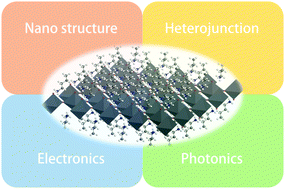当前位置:
X-MOL 学术
›
Chem. Soc. Rev.
›
论文详情
Our official English website, www.x-mol.net, welcomes your feedback! (Note: you will need to create a separate account there.)
Two-dimensional halide perovskite nanomaterials and heterostructures
Chemical Society Reviews ( IF 46.2 ) Pub Date : 2018-03-22 00:00:00 , DOI: 10.1039/c7cs00886d Enzheng Shi 1, 2, 3, 4 , Yao Gao 1, 2, 3, 4 , Blake P. Finkenauer 1, 2, 3, 4 , Akriti Akriti 1, 2, 3, 4 , Aidan H. Coffey 1, 2, 3, 4 , Letian Dou 1, 2, 3, 4
Chemical Society Reviews ( IF 46.2 ) Pub Date : 2018-03-22 00:00:00 , DOI: 10.1039/c7cs00886d Enzheng Shi 1, 2, 3, 4 , Yao Gao 1, 2, 3, 4 , Blake P. Finkenauer 1, 2, 3, 4 , Akriti Akriti 1, 2, 3, 4 , Aidan H. Coffey 1, 2, 3, 4 , Letian Dou 1, 2, 3, 4
Affiliation

|
Over the last several years, there has been tremendous progress in the development of nanoscale halide perovskite materials and devices that possess a wide range of band gaps and tunable optical and electronic properties. Particularly, the emerging two-dimensional (2D) forms of halide perovskites are attracting more interest due to the long charge carrier lifetime, high photoluminescence quantum efficiency, and great defect tolerance. Interfacing 2D halide perovskites with other 2D materials including graphene and transition metal dichalcogenides (TMDs) significantly broadens the application range of the 2D materials and enhances the performance of the functional devices. The synthesis and characterization of 2D halide perovskite nanostructures, the interface of the 2D halide perovskites with other 2D materials, and the integration of them into high-performance optoelectronic devices including solar cells, photodetectors, transistors, and memory devices are currently under investigation. In this article, we review the progress of the above-mentioned topics in a timely manner and discuss the current challenges and future promising directions in this field.
中文翻译:

二维卤化物钙钛矿纳米材料和异质结构
在过去的几年中,纳米带状钙钛矿卤化物材料和器件的开发取得了巨大的进步,这些材料和器件具有广泛的带隙和可调节的光学和电子特性。特别地,由于长的电荷载流子寿命,高的光致发光量子效率和大的缺陷耐受性,出现的二维(2D)形式的卤化物钙钛矿引起了更多的兴趣。2D卤化物钙钛矿与其他2D材料(包括石墨烯和过渡金属二卤化碳(TMDs))的接口大大拓宽了2D材料的应用范围,并增强了功能器件的性能。2D卤化物钙钛矿纳米结构的合成与表征,以及2D卤化物钙钛矿与其他2D材料的界面,目前正在研究将其集成到包括太阳能电池,光电探测器,晶体管和存储设备在内的高性能光电设备中。在本文中,我们将及时回顾上述主题的进展,并讨论该领域中当前的挑战和未来的有希望的方向。
更新日期:2018-03-22
中文翻译:

二维卤化物钙钛矿纳米材料和异质结构
在过去的几年中,纳米带状钙钛矿卤化物材料和器件的开发取得了巨大的进步,这些材料和器件具有广泛的带隙和可调节的光学和电子特性。特别地,由于长的电荷载流子寿命,高的光致发光量子效率和大的缺陷耐受性,出现的二维(2D)形式的卤化物钙钛矿引起了更多的兴趣。2D卤化物钙钛矿与其他2D材料(包括石墨烯和过渡金属二卤化碳(TMDs))的接口大大拓宽了2D材料的应用范围,并增强了功能器件的性能。2D卤化物钙钛矿纳米结构的合成与表征,以及2D卤化物钙钛矿与其他2D材料的界面,目前正在研究将其集成到包括太阳能电池,光电探测器,晶体管和存储设备在内的高性能光电设备中。在本文中,我们将及时回顾上述主题的进展,并讨论该领域中当前的挑战和未来的有希望的方向。



























 京公网安备 11010802027423号
京公网安备 11010802027423号